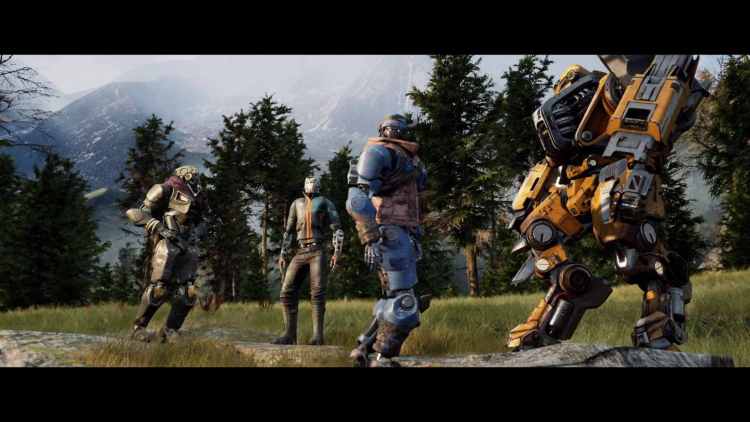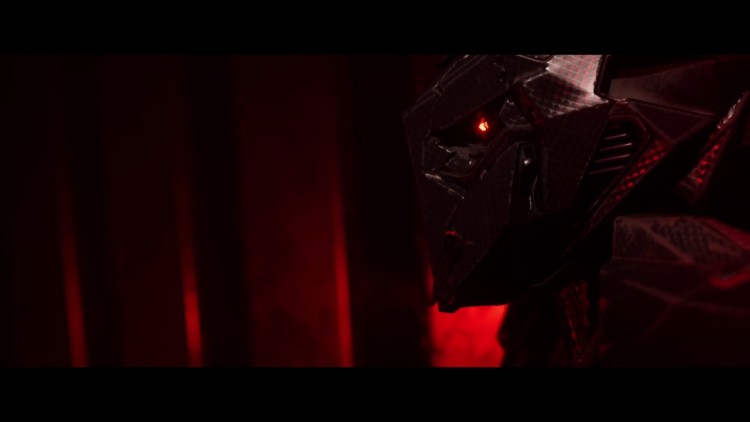At first glance, it’s easy to mistake Disintegration for another first-person shooter with a vehicular twist, considering how it was developed by V1 Interactive, a small studio headed by Halo co-creator Marcus Lehto. However, about five minutes into the campaign, it becomes apparent that there’s much more to it, since you must command a group of ground forces while maneuvering your hovercraft and shooting at waves of enemies that drop in from nowhere.
It also soon becomes apparent that, even though the game is enjoyable, it can be a little rough around the edges.
The future is history
There is an incredible amount of backstory in Disintegration — more than even the game adequately covers — but it all works to draw players into the story. In the near future where people use flying Gravcycles as a means of transportation, climate change and other global catastrophes have led much of humankind to transfer their brains into robotic armatures in a process called “integration.”
Eventually, a war erupts between an integrated faction called the Rayonne, which wants to forcibly convert everyone and turn their eyes red for some reason, and a coalition composed of naturals (fully organic humans) and their integrated supporters. You play as Romer Shoal, a former TV show host and expert Gravcycle pilot who gets caught up in the war. He and a group of outlaws are on the run from a commander named Black Shuck, who has a history with Romer. While surviving, they work to undermine Shuck’s efforts while seeking a way to be placed back into organic clones of themselves. That’s a lot to take in, but things make more sense as the game unfolds.
Integrating with Disintegration characters
Players spend most of their time flying on Gravcycles and shooting up enemies while commanding a handful of foot soldiers. The integrated soldiers, each with distinct personalities and special abilities, are what sets Disintegration apart from other first-person shooters. You come to rely heavily on them, since they add extra firepower and can distract enemies while you fly over to flank them. The characters have some interesting histories as well if you choose to listen to their stories from the world hub.
They also happen to be the only ones that can interact with objects such as supply crates, which can turn missions into a bit of a grind, since you can’t tell individual soldiers to spread out and do things. Apart from activating abilities, your crew can only be commanded to move and attack as a group, limiting the tactical potential.
Fortunately, Disintegration makes up for it by outfitting your crew with powerful abilities that can devastate large enemies when used in combination with each other. But on the other hand, they only have one special ability each, and there’s not enough variety among them. For example, there are three characters that throw grenades and carry shotguns, which makes upgrading them individually feel redundant. It’s also a little too obvious that Seguin, who throws a time-slowing grenade, is the most important because she enhances everyone else’s firepower.
Although your allies are fairly fleshed out, the same can’t be said about the villain, Black Shuck. He’s seen torturing Romer at the start of the game, then disappears for almost the entirety of the campaign. Your crew of outlaws often talks about how ruthless he is, but you never actually see him do anything. You encounter captured integrated civilians who are likely bound for brainwashing and enslavement, but it’s not like the Rayonne are actively raiding settlements, pulling people from their houses, and making examples out of those who resist. Black Shuck doesn’t appear until you battle him about halfway through the campaign. Even then, there’s little that separates Shuck from the other Gravcycle-riding enemies you encounter.
Riding the Gravcycle
You start out Disintegration with a relatively fast, lightly armored Gravcycle that sports dual HV-Rifle machine guns and a nanite launcher that heals your ground units individually. Unfortunately, the guns don’t do much damage without upgrades and have terrible accuracy, leading me to wonder why everyone was making such a big fuss about these vehicles. It wasn’t until I was a few missions in that I really got the hang of balancing between flying and ground soldier tactics.
Gravcycle types and weapons are assigned to you alongside your crew at the start of each mission. They range from the aforementioned rifles to heavy-duty autocannons and a sniper rifle that’s so powerful that it turns the game into a cakewalk on normal difficulty. The fact that enemies have limited sight but your guns have unlimited range helps to ease the campaign further.
I often wished there was customization beyond assigning stat points. Even if it were limited to choosing the secondary weapon or one accompanying crew mate, it would have been better than nothing. As it is, Disintegration‘s campaign has a very linear feel to it, with enemies popping in at predetermined moments and never respawning.
The game is also weighed down by a number of gameplay issues, including scripted events that fail to trigger because an enemy character doesn’t show up. Sometimes, an object that’s supposed to be clickable simply isn’t, forcing you to either restart from a checkpoint or the entire mission. These game-breaking issues don’t happen very often, but they occur often enough to be notable. I also experienced significant syncing issues with the cut-scene dialogue.
Firing off in multiplayer
Disintegration’s multiplayer offers nine crew types to choose from, each with different weapons, abilities, and aesthetics. Some of the crew designs are truly wacky, like the evil robotic clowns from The Sideshows crew or The Militia’s moose antlers. It makes me wish some of these crews were somehow incorporated into the campaign so that the world would be less empty and desolate.
Modes include Zone Control, which is straight-up capture-and-hold. Retrieval varies up the One Flag CTF mechanic by forcing the invading players to use their foot soldiers to carry volatile cores to a central location. Then there’s Collector, which is pretty much Headhunter from the Halo games, except that you pick up brain cans from defeated enemy players and their crew members instead of skulls and you don’t have to deposit them anywhere. Teammates may also try to pick up dropped cans to deny the opposing team points.

Earning multiplayer points and completing challenges allows you to customize the look of your colorful posse.
They may be slightly different takes on familiar multiplayer modes, but each is fast-paced and responsive. The game takes on a completely different feel when other human players are involved, especially since players are usually forced to pull up close to each other to launch devastating attacks. However, the game would benefit greatly from one or two more maps for each mode and perhaps custom modifiers. With three modes and as many maps, it’s hard to say when the multiplayer will start to feel a bit stale.
Hitting restart for humanity
Disintegration certainly has some rough edges and more than a few plot holes, particularly when it comes to a MacGuffin that doesn’t appear to further the plot in any significant way. But at the same time, the game’s Gravcycle and foot soldier mechanics offer a unique and fresh perspective on the first-person shooter genre. It’s clear that there’s a ton of unexplored lore that’s waiting to be tapped into, and I’d like to see Disintegration continue to grow as a game and franchise, refining and expanding both its gameplay and story along the way.











Published: Jun 10, 2020 09:00 am